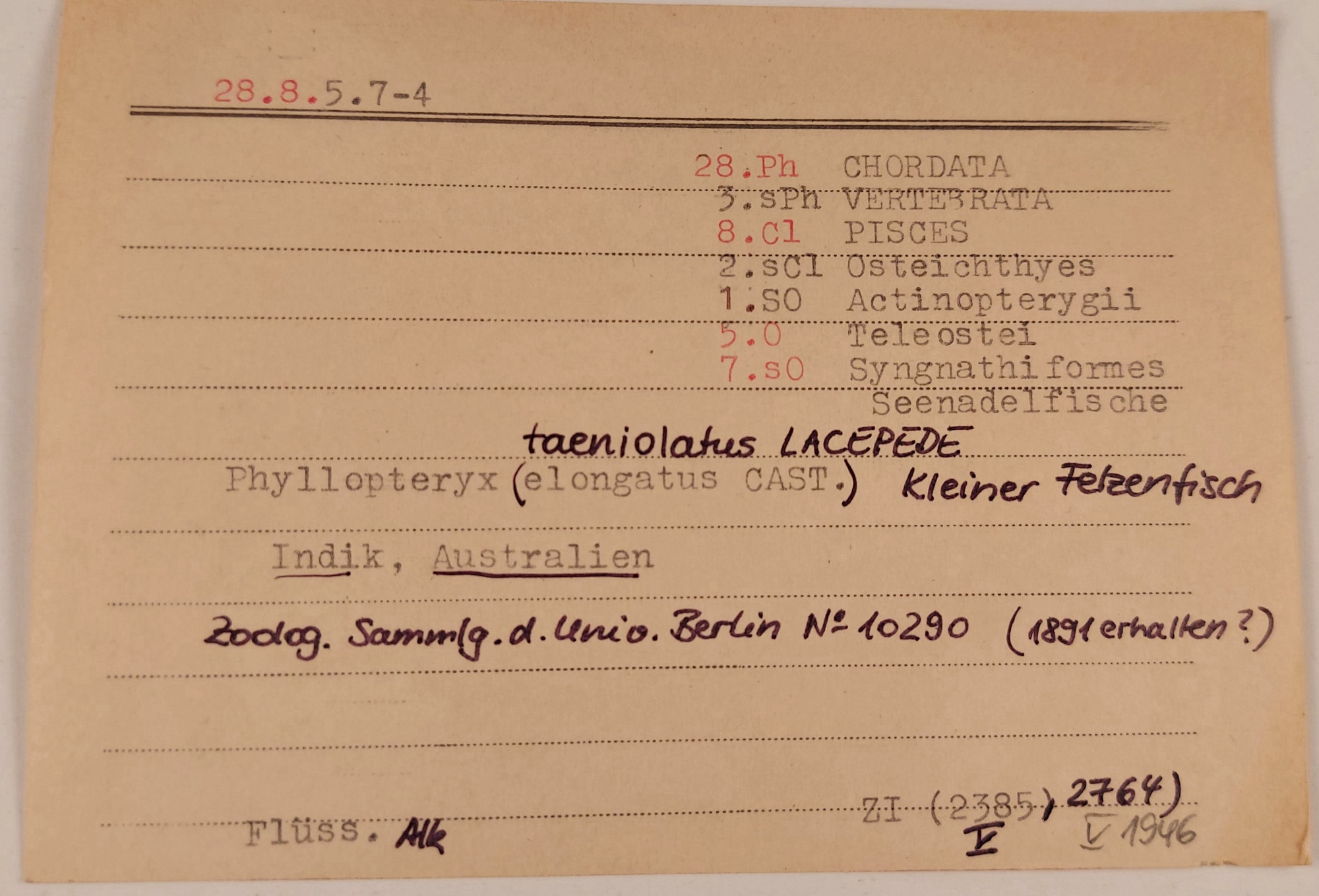
Record of a wet specimen of the common seadragon in the Zoological Teaching Collection of the Humboldt-Universität zu Berlin. (Zoological Teaching Collection. All rights reserved.)
‘28.8.5.7-4’ – visitors to the Zoological Teaching Collection at the Humboldt-Universität zu Berlin will encounter this and other similarly structured number combinations. They are numerical codes that are still being used to identify and organise the items in the collection today. These numbers are part of a system of internal organisation that Hans-Georg Herbst reformed during his management of the  teaching collection between 1968 and 1995. It was probably also Herbst who decided to make use of the
teaching collection between 1968 and 1995. It was probably also Herbst who decided to make use of the  card catalogue as an organisational tool instead of the
card catalogue as an organisational tool instead of the  inventory books that his predecessors had used to perform this task before him. Index cards like these are thus part of natural history practices for
inventory books that his predecessors had used to perform this task before him. Index cards like these are thus part of natural history practices for  Recording Worlds. Each item in the collection is represented by a specific numerical code and an accompanying index card. And the numbers have not been chosen randomly: they classify the specimens and models according to
Recording Worlds. Each item in the collection is represented by a specific numerical code and an accompanying index card. And the numbers have not been chosen randomly: they classify the specimens and models according to  zoological taxonomy, an artificial system or order that groups living creatures into hierarchical categories, each based on joint characteristics and evolutionary relationships.
zoological taxonomy, an artificial system or order that groups living creatures into hierarchical categories, each based on joint characteristics and evolutionary relationships.
The number ‘28.8.5.7-4’ for the specimen of a common seadragon (Phyllopteryx taeniolatus Lacépède) represents the taxonomic categories of phylum, class, order, and species, which thus identify this specimen as a syngnathid. The index card pictured here displays a legend that maps out this hierarchy, from the largest unit, the phylum 28, which here is the Chordata group, down to the smallest category, the species 4, which in this case is the common seadragon. Animals that belong to this species are thus vertebrates (of the subphylum Vertebrata), belong to the class 8 of fish and the subclass 5 of Teleostei, and are Syngnathiformes on the level of order 7.
The principle of numerical codes in the teaching collection is complex and yet unstable, especially when trying to keep up with the developments continuously taking place in the taxonomic system. New species are being discovered, the demarcations between various hierarchies dissolved, and new intercategories are asserting themselves. What is more, some items in the teaching collection have an additional number and are grouped or placed together due to the type of object they are. The reason for this is the pragmatic way that they must be stored for teaching. It is then the task of the people working in the collection to adjust the numbering, to relabel the objects, and to reorder the index cards and the objects.
Transcript
28.8.5.7-4
28.Ph CHORDATA / 3.sPh VERTEBRATA / 8.C1 FISH / 2.sC1 Osteichthyes / 1.S0 Actinopterygii / 5.0 Teleostei / 7.s0 Syngnathiformes / Syngnathids
Phyllopteryx (elongatus CAST.) [handwritten above the brackets:] taeniolatus LACEPEDE / common seadragon
Indic Ocean, Australia
[handwritten:] Zoolog. Collection. of Univ. Berlin No 10290 (received 1891?)
Liquid [handwritten:] Alc
ZI (2385, [handwritten:] 2764) / V / V 1946